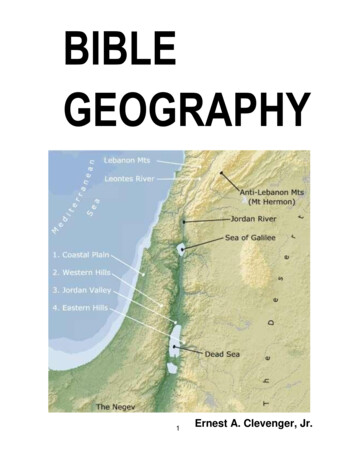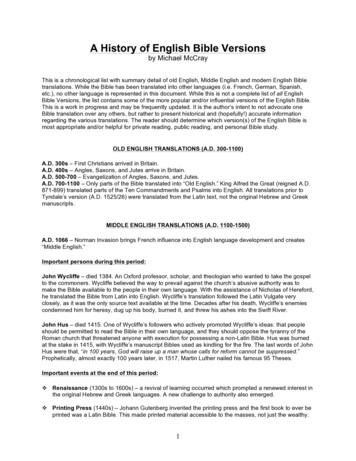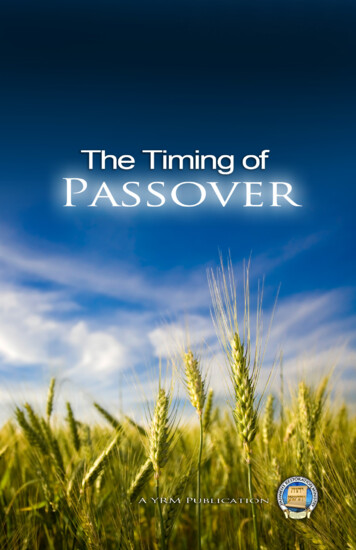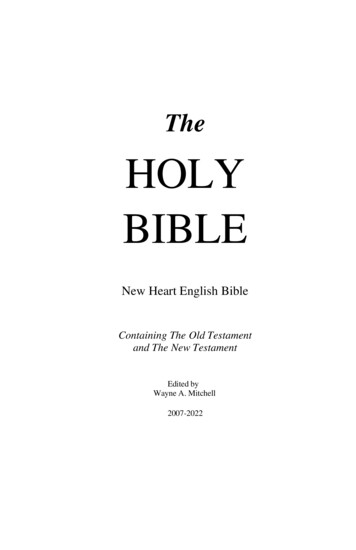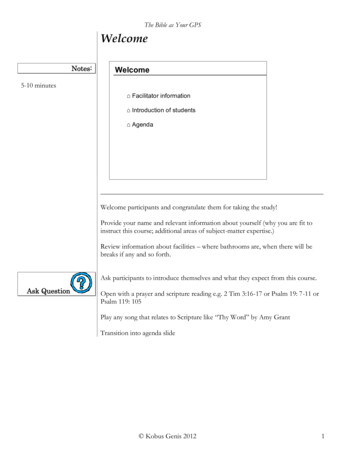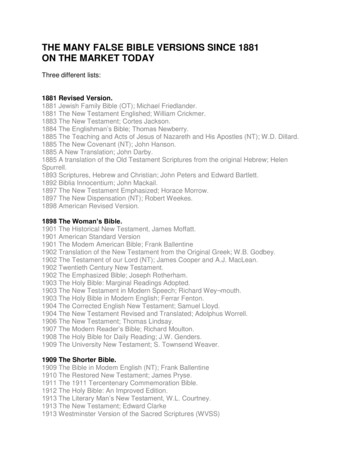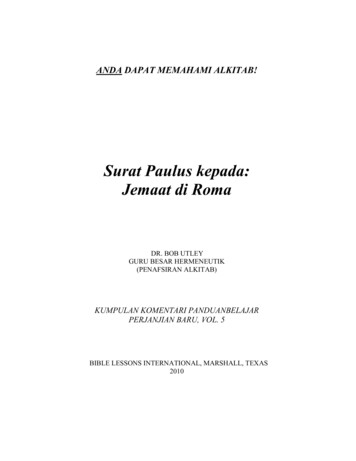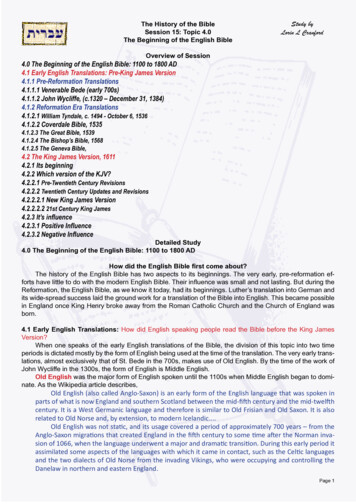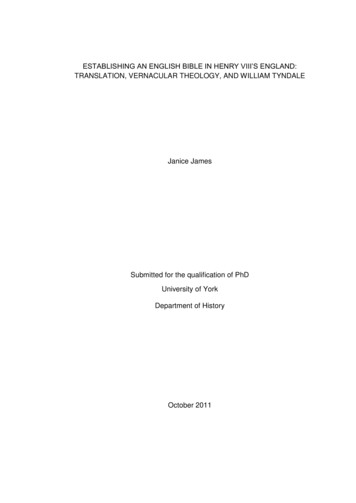
Transcription
ESTABLISHING AN ENGLISH BIBLE IN HENRY VIII’S ENGLAND:TRANSLATION, VERNACULAR THEOLOGY, AND WILLIAM TYNDALEJanice JamesSubmitted for the qualification of PhDUniversity of YorkDepartment of HistoryOctober 2011
ABSTRACTIn the 1520s, thanks to the infiltration into England of Martin Luther’s books, theEnglish government began a dedicated campaign to protect the country fromheresy. Their efforts, though substantial, failed to stem the tide of heresy. Thoughhe was living in exile in the Low Countries, William Tyndale was the leadingvernacular spokesman of the first generation of English religious reformers. He wasalso England’s most talented early sixteenth-century Bible translator. Tyndale’sopponents perceived him to be the greatest threat to the preservation of thetraditional faith in England.This thesis argues that Tyndale’s position in modern historiography does notaccurately reflect the one he held in his own day and that the erroneous portrayal isdue to an inadequate examination of important aspects of the coming forth of thefirst printed editions of the English Bible. The areas of neglect include: the extent ofthe Biblical content of orthodox vernacular religious books published prior to 1526,English authorities’ perceptions of the social and political impact of an English Bible,Tyndale’s motivations for translating the Bible, the English government’s rejection ofTyndale’s English New Testament, and Tyndale’s theological influence on latertranslations of the English Bible.Drawing on all of Tyndale’s published works, the body of vernacular religiouswritings printed between 1500 and 1525, and on the six cardinal English Bibletranslations between 1535 and 1611, this thesis demonstrates Tyndale’s significantcontributions to the English Reformation. It shows that Tyndale’s 1526 English NewTestament filled lay desire for an English Bible, that Tyndale was a formidabletheologian who developed a distinct theology and a unique Bible-based socialstructure, and that Tyndale exerted considerable influence over English vernaculartheology as well as on the theology of the English Bibles that followed his owntranslations.2
TABLE OF pter One—Crumbs from the Master’s Table:Biblical Content in Printed English Books 150015251. Lay Access to English Translations of theBible2. Scriptural Content in English ReligiousPublications17Chapter Two—A Famine of Hearing the Words ofthe Lord: England’s lack of a Printed VernacularBible1. Sixteenth-Century Perceptions of JohnWycliffe2. Fears of Heresy, Rebellion, and theDestruction of the Traditional Social Structure3. William Tyndale’s Bible-based Social Structure61Chapter Three—Ten Thousand Words in anUnknown Tongue: Translation of the Bible intoEnglish1. Tyndale, Erasmus, and Humanism2. Tyndale and Erasmus’ Theology Programme104Chapter Four—Cast into the Midst of a BurningFiery Furnace: Official reactions to Tyndale’s1526 New Testament1. Burning the English New Testament2. The Tokens of the Malice of a Heretic147Chapter Five—What Doctrine is this? VernacularTheology and William Tyndale1. Vernacular Theology in England Prior to the1520s2. ‘Congregation’, ‘Senior/Elder’, and ‘Love’3. Conclusion193Conclusion240List of Abbreviations249Note on Online 2182393
ACKNOWLEDGEMENTSSince this is a thesis about English scripture, it is fitting to begin myacknowledgements with a favourite passage from Alma 37:37: ‘Counsel with theLord in all thy doings, and he will direct thee for good’. Though it may go againstacademic tradition to acknowledge a divine source of help in completing one’sthesis, my conscience requires it of me. Therefore, I gratefully and humblyacknowledge God’s help, direction, support, and encouragement as I have labouredto complete this project. His assistance has been crucial and I could not havecompleted this thesis without it. He has unfailingly answered my prayers at eachstage of my work and has inspired me in all of my thoughts and ideas. I give all thecredit for succeeding in this project to Him.My next acknowledgments go to my supervisor, John Cooper, and to my advisorycommittee, Bill Sheils and Kevin Killeen. These men have been encouraging,supportive, and helpful throughout. They have stimulated me with their constructivecriticism and taught me to approach my subject matter from different angles by theirsuperior knowledge, experience, and extensive expertise. I am grateful for theirconfidence in me and for their advice and assistance.I come to my family and friends last, though they are not last in my thoughts. I amespecially grateful for the support of my parents, Morris and Coleen James. Theyhave believed in me and have supported me in countless ways. Extra specialacknowledgments go to my two closest friends, Elizabeth Feil and Ann Bryner.They have been my long-distance lifelines during all of the years working tocomplete my MA and my PhD. Though words on a page cannot convey howimportant their presence in my life has been, I could not have survived without them.I am so grateful for the many hours of conversation we’ve had, for the much neededlaughter and distraction that they have provided, and for their continualencouragement and support. They have truly been living versions of the Lord’stender mercies.4
INTRODUCTIONIn 1516, against considerable opposition by some contemporary theologians,Desiderius Erasmus published a bilingual edition of the New Testament.1 Itcontained a corrected text of the Latin Vulgate facing a Greek text from which thecorrections to the Latin had been made.2 In response to theologian Maarten vanDorp’s objections to his intended work on the Vulgate, Erasmus explained hisrationale:There are often passages [in the Latin Vulgate] where the Greek has beenbadly translated because of the inexperience or carelessness of thetranslator, and often a true and faithful reading has been corrupted byuneducated copyists . . . or sometimes even altered by half-educated scribesnot thinking what they do. Then who is giving his support . . . the man whocorrects and restores these texts or the man who would rather accept anerror than remove it?3Staying true to his belief that the Vulgate was defective as a translation, Erasmus‘revised the whole New Testament . . . against the standard of the Greek original,’the language in which the New Testament had initially been written, and insisted thatwhere the two texts differed, the Greek text should have the greater authority.4When the Novum Instrumentum was published, it created enormous shock wavesthroughout Europe. The Vulgate Bible had enjoyed unrivalled authority in thewestern Christian church for more than eight hundred years, and a number ofchurch doctrines and practices, such as the doctrine of the Trinity or the practice ofdoing penance, had been established and upheld on the basis of the Vulgate’swording.5 Erasmus’ ad fontes approach to scripture challenged the authority of theVulgate as well as the authority of the church. Religious reformers, including MartinLuther himself, were inspired by Erasmus’ work and used it as support for rejectingtraditional church practices and beliefs.6William Tyndale, a graduate of Oxford University and a reform-minded priest,was among those inspired by Erasmus’ ideas and publications. He was particularly1Erika Rummel, Erasmus (London: Contiuum, 2004), 76.2Anne M. O’Donnell & Jared Wicks, eds., An Answere unto Sir Thomas Mores Dialoge(Washington D.C.: The Catholic University of America Press, 2000), xxi.3CWE, vol. 71, Ep. 337:804, 384:222-23.4Ibid, Ep. 384:226.5Allan Jenkins and Patrick Preston, Biblical Scholarship and the Church: A SixteenthCentury Crisis of Authority (Aldershot: Ashgate, 2007), 59, 93.6Jenkins, Biblical Scholarship, ix-xi.5
moved by Erasmus’ insistence that there should be universal access to the Biblethrough vernacular translation. According to John Foxe, author of Acts andMonuments, Tyndale’s resolution to make the first English translation of the Biblefrom the original languages had been formed by 1523. By this time, Tyndale hadgraduated from Oxford and was living in Gloucestershire where he worked as aprivate tutor for Sir John and Lady Walsh of Little Sodbury Manor.7 Becausetranslation of the Bible into English without the approval of a Bishop had been illegalsince 1409, Tyndale sought permission to translate from the Bishop of London,Cuthbert Tunstal, in the summer of 1523.8 Though his petition was denied, Tyndaleremained undaunted and went into self-imposed exile in the Low Countries in 1524.9From there he published the first complete printed English New Testament in 1526and a revised edition in 1534. Tyndale also published an English translation of thePentateuch in 1530 and a translation of the book of Jonah in 1531. BecauseTyndale was executed in 1536, his translation of the Old Testament books of Joshuathrough 2 Chronicles was published posthumously in 1537.10 Tyndale’s literaryactivities were not limited to Bible translation. He also published many polemicaland exegetical works, such as the Obedience of a Christian Man (1528), TheParable of the Wicked Mammon (1528), The Practyse of Prelates (1530), and AnAnswere unto sir Thomas Mores Dialoge (1531).Tyndale’s biblical, polemical, and exegetical books made him the ‘leadingvernacular spokesman of the first generation’ of English religious reformers.11Andrew Hope argues that Thomas More, England’s primary lay defender of theestablished church, perceived Tyndale ‘as the greatest of threats to CatholicChristianity’ in England.12 Paul Arblaster believes that, in the sixteenth century,Tyndale was ‘seen by friend and foe alike as the intellectual father of English7John Foxe, Actes and monuments of these latter and perillous dayes (1563), STC (2nd ed.)/ 11222, EEBO, 514, image 297L.8David Daniell, William Tyndale: A Biography (New Haven: Yale University Press, 1994), 8386.9Gergely Juhasz & Paul Arblaster, ‘Can Translating the Bible Be Bad for Your Health?William Tyndale and the Falsification of Memory’ in More than a Memory: The Discourse ofMartyrdom and the Construction of Christian Identity in the History of Christianity, ed. JohanLeemans (Leuven: Peeters, 2005), 316.10O’Donnell, Answere, xxi.11Juhasz & Arblaster, ‘Bad for Your Health’, 317.12Andrew Hope, ‘Plagiarising the Word of God: Tyndale between More and Joye’ inPlagiarism in Early Modern England, ed. Paulina Kewes (Basingstoke: Palgrave Macmillan,2003), 103.6
Protestantism’.13 The English government certainly believed that Tyndale and hiswritten works were dangerous. Beginning in October 1526, Tyndale’s Bibletranslations and other books were banned, burned, and repeatedly included in royalproclamations that prohibited heretical English books throughout the next decade.14Moreover, beginning in the late 1530s when the Henry VIII’s government allowedEnglish Bibles to circulate among the people and insisted that an English Bible beplaced in every parish church, Tyndale’s name was thought to be too dangerous areminder of heresy to be mentioned in association with those Bibles, even thoughthe six cardinal English translations between 1535 and 1611 were all heavily basedon Tyndale’s work.15 Hope has described this unacknowledged use of Tyndale’stranslations as ‘the greatest single act of plagiarism of the sixteenth century’. 16In spite of Tyndale’s prominent position as England’s leading reformer andmost talented early sixteenth-century Bible translator, modern historiography admitsthat Tyndale has not been given the scholarly attention he deserves. Arblasterwrites that Tyndale was ‘a man whose lasting influence has been so profound that itis easy to miss it entirely.’17 The first biographical information about Tyndale waspublished in the 1563 edition of Foxe’s Acts and Monuments. Foxe’s accountsupplied everything that was known about Tyndale’s life until 1845 when ChristopherAnderson published the Annals of the English Bible; a book that was originallydesigned to be a life of Tyndale but was extended beyond that purpose.18Subsequent biographers, Robert Demaus (1886), J.F. Mozley (1937), and DavidDaniell (1994) have continued to rely on Foxe’s account, but with their differingstyles and areas of emphasis, have attempted to use the available sources to bringTyndale out of obscurity and to clear his historical reputation of what they have felt13Paul Arblaster, ‘Tyndale’s Posthumous Reputation’ in Tyndale’s Testament, eds. PaulArblaster, Gergely Juhász, & Guido Latré (Turnhout: Brepolis Publishers, 2002), 55.14Paul L. Hughes & James F. Larkin, eds., Tudor Royal Proclamations, vol.1 (New Haven:Yale University Press, 1964), 177, 191; Alfred W. Pollard, ed., Records of the English Bible(Oxford: Oxford University Press, 1911), 241.15Pollard, Records, 200-232, 240; Naomi Tadmor, The Social Universe of the English Bible:Scripture, Society, and Culture in Early Modern England (Cambridge: Cambridge UniversityPress, 2010), 4.16Hope, ‘Plagiarizing the Word of God’, 105.17Arblaster, ‘Tyndale’s Posthumous Reputation’, 55.18Robert Demaus, William Tyndale: A Biography (London: Religious Tract Society, 1886),10.7
to be ignorance, partisanship, and error.19 Daniell remarks that Tyndale has been‘unfairly neglected’ in the tide of scholarly books and articles concerning Englishhistory, literature, theology, and language. In his opinion, ‘very little has yet beendone on [Tyndale]’ even though there is room for study in ‘every aspect of his life’,particularly in the area of Bible translation.20Daniell’s assessment of the work that still remains to be done concerningTyndale is a legitimate one, though since making that assessment in 1994, theamount of scholarship pertaining to Tyndale has increased considerably. Inpreparation for the celebration of the four hundredth anniversary of the publication ofthe King James Bible (KJB) in 2011, many books and articles on the translation ofthe Bible into English have recently been published. Given Tyndale’s pioneeringwork in rendering the original Biblical languages into English, he has figuredprominently in that scholarship; mostly receiving credit for significantly shaping theEnglish language as a whole and for influencing societal perceptions and behavioursas a result.For instance, Naomi Tadmor’s study on the English language of the OldTestament acknowledges that the English Bible was formed over time in acumulative process that was influenced largely by the cardinal translations madebetween 1526 and 1611.21 Tadmor argues that Tyndale’s 1530 translation of thePentateuch had a ‘major influence on subsequent English biblical versions’ becauseof how he chose to transpose, mould, and render the Hebrew language into termsthat ‘made sense to the people at that time and invoked certain notions and ideas’.Tyndale, therefore, not only had an impact on individual words of the English OldTestament, but he influenced the ‘construction’ of the social universe portrayed inthe English Bible which provided proof for the social and cultural values and normsof contemporary society.22Tadmor’s study is an important one, not only because it successfullyilluminates the significant effect Tyndale had on English Bible translation, butbecause it demonstrates how the language of the early English Bibles affectedsociety as a whole; a critical point in rectifying what Daniell has described asscholarly ‘Bible-blindness’, or the deliberate exclusion of the Bible from ‘discussions19Demaus, William Tyndale, 12; J. F. Mozley, William Tyndale (New York: The MacMillanCompany, 1937), v; Daniell, William Tyndale, 4.20Daniell, William Tyndale, 4.21Tadmor, Social Universe, 8.22Ibid, 17, 20.8
of events and experiences in British and American history’.23 Tadmor is not the onlyscholar to notice Tyndale’s influence on the English language in general and on theEnglish Bible in particular. David Crystal’s study of the King James Bible’scontribution to English idiomatic expressions demonstrates that even though theKing James Bible did ‘more to fix’ particular expressions in the minds of Englishspeakers than any other source, a significant amount of ‘the memorabledistinctiveness of the KJB . . . originated in Tyndale’.24 Clearly, Tyndale is starting tobe given his due, at least as far as his contribution to the English language isconcerned.25Closely connected with the scholarship pertaining to Tyndale and thetranslation of the English Bible is the research related to the written debate that wasconducted between Thomas More and Tyndale between 1529 and 1532. A portionof that debate was about the English language and centred on the particular Englishwords, ‘congregation’, ‘elder’, and ‘love’, that Tyndale used in rendering thetheologically charged Greek words ekklēsia, presbuteros, and agapē. The mostrecent research on the More/Tyndale debate, however, has not focused on theirdisagreements over the language of translation, but has covered many of their othermajor arguments including: how to interpret the Biblical text, authority of the churchversus authority of scripture, and historical faith versus feeling faith.26 Gregoryexplains that the ‘continuing fascination with the clash between Tyndale and More’shows ‘no signs of letting up’ and admits that the critical editions of Tyndale’s works,soon to be published, ‘will almost certainly spur further scholarship’.27In spite of this recent research, the historiography pertinent to Tyndale andhis efforts to provide England with a vernacular Bible has not adequately addressedsome important and often glaringly basic questions that are crucial for understandingthe early years of the English Reformation. These questions are: first, how muchwritten Biblical content was available to lay people prior to Tyndale’s 1526 English23David Daniell, The Bible in English (New Haven: Yale University Press, 2003), xiii, xv.24David Crystal, The King James Bible and the English Language (Oxford: Oxford UniversityPress, 2010), 7, 262.25Arblaster, ‘Tyndale’s Posthumous Reputation’, 55.26See Gregory, ‘Tyndale and More’, 177-191; Tibor Fabiny, ‘Church Paradigm versusScripture Paradigm in the Debate of Sir Thomas More and William Tyndale,’ in RepresentingReligious Pluralization in Early Modern Europe, ed. Andreas Höfele (London: Lit, 2007), 1543; David Weil Baker, ‘The Historical Faith of William Tyndale: Non-Salvific Reading ofScripture at the Outset of the Reformation,’ Renaissance Quarterly 62 (2009): 661-92.27Brad Gregory, ‘Tyndale and More, In Life and In Death,’ Reformation 8, (2003): 173, 174.9
translation of the New Testament? Second, why did the English government resisttranslating the Bible into English? Third, what motivated Tyndale to make anEnglish translation of the Bible? Fourth, why was Tyndale’s translation rejected bythe English government? And fifth, how did the language Tyndale used in histranslations of the English New Testament compare with the language of the popularvernacular religious texts of the early sixteenth century, and what impact did Tyndalehave on the vernacular theology of later translations of the English Bible?Chapter one seeks to answer the first question by examining the Biblicalcontent in non-heretical printed vernacular religious works published between 1500and 1525. In the early stages of the English Reformation, lay access to the Biblewas a matter of significant polemical debate. Tyndale, John Frith, and WilliamBarlow are among the early sixteenth-century authors who vociferously accused thetraditional church of purposefully withholding the Bible from lay people. However, inmodern historiography, this subject is lightly passed over or incorporated intoarguments about whether or not there was a need for an English translation of theBible, and whether or not religious and secular leaders would have provided onehad English reformers not forced the issue.Eamon Duffy is one revisionist author who insists that English lay peoplewere satisfied with the religious texts that they had, such as Books of Hours orgospel harmonies, and that the English clergy would have eventually provided laypeople with a vernacular Bible.28 Daniell, on the other hand, declares that the Booksof Hours and gospel harmonies did nothing to satiate lay hunger for an EnglishBible, and that the church leaders in England would ‘never’ have permitted a‘complete printed New Testament in English’.29 Interestingly, neither Duffy norDaniell provide very extensive textual evidence to support their arguments. They dolittle directly to analyse how much and what kind of Biblical content lay people hadaccess to prior to Tyndale’s New Testament and because of that cannot adequatelyargue what the effects of that exposure might have been or how interested laypeople were in having an English translation of the Bible. Clearly, a thoroughexamination of the scriptural content in the early sixteenth-century printed religiousbooks is long overdue.Therefore, chapter one presents a detailed analysis of the Biblical content infive early sixteenth-century printed religious books. These texts were chosen for28Eamon Duffy, The Stripping of the Altars, 22005), 4, 79.29ndedition, (New Haven: Yale University Press,Daniell, William Tyndale, 100.10
their popularity and because they represent the different types of non-hereticalvernacular religious publications that were available in the early sixteenth century:printed sermons, gospel harmonies, and devotional aids. The analysis examinesevery reference to the Bible that can be found in these texts and will demonstratethat these books contain considerably more scriptural content than has generallybeen recognized by scholars, including Duffy and Daniell, and that the content istheologically clear and profound. Moreover, nearly all of the authors of these textsencouraged their readers to study the Bible for themselves because they felt thatpersonal scripture study was a spiritual necessity. The chapter concludes byarguing that the scriptural content in early sixteenth-century vernacular religioustexts, along with their authors’ encouragement to study the Bible, contributed to laydemand for a complete English translation of the Bible.Chapter two seeks to answer the question about why the Englishgovernment resisted translating the Bible into English. Modern scholarship accountsfor England’s lack of a vernacular Bible by concluding that sixteenth-centuryreligious and secular leaders were afraid that a vernacular Bible would spark heresyand rebellion among the people. Glyn Redworth and Gillian Brennan are among thescholars who argue that these fears were founded on England’s experience withWycliffe and his followers, the Lollards, during the late fourteenth and early fifteenthcenturies.30 In spite of this accepted connection, however, historiographers haveoverlooked the fact that Wycliffe’s name figures prominently in the early sixteenthcentury discourse about heresy and have failed to investigate its significance. Thischapter seeks to rectify that oversight and explores how Wycliffe’s name was usedby English authorities in the early days of the English Reformation to create an‘historical heresy’, a chain of heretics stretching back to the primitive church. It willdemonstrate that English authorities used this ‘historical heresy’ to undermine thereformers, justify England’s lack of a vernacular Bible, and bolster their own position.Chapter two will also show that English authorities were afraid that thetraditional social hierarchy would be destroyed if a vernacular Bible was madeavailable to all. As discussed above, modern scholarship generally explainsEngland’s lack of a vernacular Bible by focusing on fears of rebellion and heresy, butthis practice glosses over the equally important concerns about the social structure.30Daniell, The Bible in English, 11; Henry Wansbrough, ‘Tyndale’ in The Bible in theRenaissance, ed. Richard Griffiths (Aldershot: Ashgate, 2001), 119; Richard Griffiths,‘Introduction’, in Griffiths, The Bible in the Renaissance, 4; Glyn Redworth, ‘Whateverhappened to the English Reformation?’ History Today, 37 (1987): 32; Gillian Brennan,‘Patriotism, Language and Power: English Translations of the Bible, 1520-1580,’ HistoryWorkshop Journal, 27 (1989): 27.11
Though some authors, such as Gergely Juhász, acknowledge that Englishauthorities perceived the English Bible to be a ‘threat’ to the ‘social’ order, there hasbeen little exploration into the details of the subject.31 A detailed analysis of More’sDyaloge concerning heresies and Tyndale’s Obedience of a Christen Man willdemonstrate that there was a debate between the two authors about how to obtainand maintain social harmony, and that both of them were acutely aware that avernacular Bible could be used to alter the traditional social structure. The analysiswill also show that Tyndale developed a unique Bible-based social structure that hehoped would supplant the traditional one. This discovery lends itself to a laterargument that Tyndale was a capable theologian who developed and taught his ownunique brand of theology and that he deserves to be acknowledged for hisintellectual achievements.The most obvious of Tyndale’s accomplishments was his pioneering Englishtranslation of the New Testament. Brian Cummings has stated that ‘the creation ofthe English Bible’ was ‘the most significant literary event by far of the sixteenthcentury (Shakespeare included).’32 If this is true, it would be important tounderstand why Tyndale was motivated to make the first ever printed Englishtranslation of the New Testament from the original languages. After all, the 1526and 1534 editions of his translation later became the foundation of all other EnglishBibles that came thereafter.Unfortunately, modern historiography’s explanations for Tyndale’smotivations are woefully inadequate. Anthony Levi and John King assert thatTyndale was inspired by Erasmus’ Paraclesis while Daniell simply claims thatTyndale was ‘inspired by God’.33 Yet, a fuller explanation is possible if all ofTyndale’s writings are taken into account and are gleaned for what they reveal abouthis sources of inspiration. Chapter three will show that Tyndale’s motivations fortranslating the Bible centred on what he learned from Erasmus. We will find thatTyndale was thoroughly acquainted with Erasmus’ written works and that Erasmushad a greater impact on him than any other person; even Martin Luther. A detailed31Gergely Juhász, ‘Antwerp Bible Translations in the King James Bible’ in The KJB after 400years: Literacy, Linguistic, and Cultural Influences, eds. Hannibal Hamlin & Norman W.Jones, (Cambridge: Cambridge University Press, 2010), 101.32Brian Cummings, ‘Reformed Literature and Literature Reformed’ in Cambridge History ofMedieval English Literature, ed. David Wallace (Cambridge: Cambridge University Press,1999), 824.33Daniell, William Tyndale, 59, 61, 79, 83, 92–93; Anthony Levi, Renaissance andReformation: The intellectual genesis (New Haven: Yale University Press, 2002), 339; JohnN. King, English Reformation literature: The Tudor Origins of the Protestant Tradition(Princeton: Princeton University Press, 1982), 46.12
examination of Erasmus’ humanist training programme for theology students, theMethodus verae theologiae, combined with a thorough textual analysis of all ofTyndale’s published works, will reveal that Erasmus’ Methodus provided Tyndalewith the five humanist principles that became the foundation of all of his work.These principles helped Tyndale develop into an Erasmian theologian and as such,he translated the Bible into English to fulfil his responsibilities.Chapter three also shows that scholars, such as Diarmaid MacCulloch andRichard Rex, who denigrate Tyndale to the level of a follower, either of Luther or ofErasmus, are mistaken.34 When all of Tyndale’s written works are taken intoaccount, they show that even though he obtained many of his ideas from Luther andErasmus, Tyndale also boldly disagreed with them on many significant points, suchas justification by faith or the doctrine of free will. Tyndale, therefore, was not afollower, but was an intelligent man who effectively used the work of those headmired in the development of his own distinctive theology. His unique doctrinalposition contributed to making the English Reformation distinct from the reformmovements on the Continent.Tyndale’s 1526 New Testament was not received by the English authoritieswith anything like enthusiasm. Chapter four explores why the volume wasadamantly rejected by the English government. It seeks to adjust modernhistoriographers’ views that the translation was burned because of textual error, assome scholars, such as Charles Sturge and John King, have asserted.35 Byfocusing on the Bishop of London, Cuthbert Tunstal, who presided over andpreached at the first official burning of Tyndale’s New Testament in October 1526,and on Thomas More, who wrote, in English, against the translation in 1528, chapterfour will reveal that government authorities burned Tyndale’s New Testamentbecause Tyndale was a malicious heretic, not because of textual error in thetranslation. The textual errors in Tyndale’s New Testament, though objectionable,were ultimately considered to be the tokens, or evidence, of Tyndale’s incurablemalice. The English authorities perceived malice to be an infectious disease thatcould be spread through the written and spoken word and they desired to preventthe innocent and /or ignorant from contracting it through Tyndale’s New Testament.34See Diarmaid MacCulloch, Reformation: Europe’s House Divided (London: PenguinBooks, Ltd., 2003), 580–81; King, English Reformation, 46; Richard Rex, Henry VIII and thendEnglish Reformation, 2 edition (New York: Palgrave Macmillan, 2006), 113.35Charles Sturge, Cuthbert Tunstal: Churchman, Scholar, Statesman, Administrator(London: Longmans, 1938), 23; John N. Ki
translations and other books were banned, burned, and repeatedly included in royal proclamations that prohibited heretical English books throughout the next decade.14 Moreover, beginning in the late 1530s when the Henry VIII’s government allowed English Bibles to circulate among the peop
